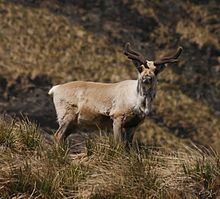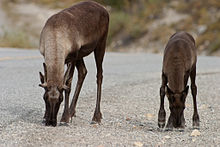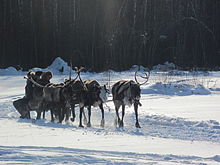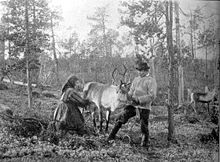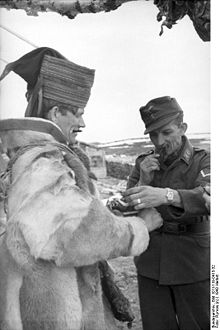- Reindeer
-
"Caribou" redirects here. For other uses, see caribou (disambiguation). For other uses of "reindeer", see reindeer (disambiguation).
Reindeer 
Conservation status Scientific classification Kingdom: Animalia Phylum: Chordata Class: Mammalia Order: Artiodactyla Family: Cervidae Subfamily: Capreolinae Genus: Rangifer
C.H. Smith, 1827Species: R. tarandus Binomial name Rangifer tarandus
(Linnaeus, 1758)Subspecies many, see text

Reindeer habitat divided into North American and Eurasian parts The reindeer (Rangifer tarandus), also known as the caribou in North America, is a deer from the Arctic and Subarctic, including both resident and migratory populations. While overall widespread and numerous,[1] some of its subspecies are rare and one (or two, depending on taxonomy) has already gone extinct.[2][3]
Reindeer vary considerably in color and size. Both sexes grow antlers, though they are typically larger in males. There are a few populations where females lack antlers completely.
Wild reindeer hunting and herding of semi-domesticated reindeer (for meat, hides, antlers, milk and transportation) is important to several Arctic and Subarctic people.[4] Even far outside its range, the reindeer is well known due to the myth, probably originating in early 19th century America, in which Santa Claus's sleigh is pulled by flying reindeer, a popular secular element of Christmas.[5] In Lapland, reindeer pull pulks.[6]
Contents
Distribution and habitat
The reindeer is a widespread and numerous species in the northern Holarctic, being present in both tundra and taiga (boreal forest).[7] Originally, the reindeer was found in Scandinavia, eastern Europe, Russia, Mongolia, and northern China north of the 50th latitude. In North America, it was found in Canada, Alaska (USA), and the northern conterminous USA from Washington to Maine. In the 19th century, it was apparently still present in southern Idaho.[1] It also occurred naturally on Sakhalin, Greenland, and probably even in historical times in Ireland. During the late Pleistocene era, reindeer were found as far south as Nevada and Tennessee in North America and Spain in Europe.[7][8] Today, wild reindeer have disappeared from many areas within this large historical range, especially from the southern parts, where it vanished almost everywhere. Large populations of wild reindeer are still found in Norway, Finland, Siberia, Greenland, Alaska, and Canada.
Domesticated reindeer are mostly found in northern Fennoscandia and Russia, with a herd of approximately 150-170 reindeer living around the Cairngorms region in Scotland. The last remaining wild tundra reindeer in Europe are found in portions of southern Norway.[9]
A few reindeer from Norway were introduced to the South Atlantic island of South Georgia in the beginning of the 20th century. The South Georgian reindeer total some 2600 animals in two distinct herds separated by glaciers. Although the flag and the coat of arms of the territory contain an image of a reindeer, they are under threat of eradication because of the environmental damage they cause. Around 4000 reindeer have been introduced into the French sub-Antarctic archipelago of Kerguelen Islands. East Iceland has a small herd of about 2500–3000 animals.[10]
Caribou and reindeer numbers have fluctuated historically, but many herds are in decline across their range.[11] This global decline is linked to climate change for northern, migratory caribou and reindeer herds and industrial disturbance of caribou habitat for sedentary, non-migratory herds.[12]
Morphology
Size
The females usually measure 162–205 cm (64–81 in) in length and weigh 79–120 kg (170–260 lb)[13] The males (or "bulls") are typically larger (although the extent to which varies in the different subspecies), measuring 180–214 cm (71–84 in) in length and usually weighing 92–210 kg (200–460 lb), though exceptionally large males have weighed as much as 318 kg (700 lb).[13] Shoulder height typically measure from 85 to 150 cm (33 to 59 in), and the tail is 14 to 20 cm (5.5 to 7.9 in) long. The subspecies R. t. platyrhynchus from Svalbard island is very small compared to other subspecies (a phenomenon known as insular dwarfism), with females having a length of approximately 150 cm (59 in), and a weight around 53 kg (120 lb) in the spring and 70 kg (150 lb) in the autumn.[14] Males are approximately 160 cm (63 in) long, and weigh around 65 kg (140 lb) in the spring and 90 kg (200 lb) in the autumn.[14] The reindeer from Svalbard are also relatively short-legged and may have a shoulder height of as little as 80 cm (31 in),[14] thereby following Allen's rule.
Domesticated reindeer are shorter-legged and heavier than their wild counterparts.
Fur
The colour of the fur varies considerably, both individually, and depending on season and subspecies. Northern populations, which usually are relatively small, are whiter, while southern populations, which typically are relatively large, are darker. This can be seen well in North America, where the northermost subspecies, the Peary caribou, is the whitest and smallest subspecies of the continent, while the southermost subspecies, the Woodland Caribou, is the darkest and largest.[15] The coat has two layers of fur, a dense woolly undercoat and longer-haired overcoat consisting of hollow, air-filled hairs.
Antlers
In most populations both sexes grow antlers,[16] which (in the Scandinavian variety) for old males fall off in December, for young males in the early spring, and for females in the summer. The antlers typically have two separate groups of points, a lower and upper. There is considerable subspecific variation in the size of the antlers (e.g., rather small and spindly in the northernmost subspecies),[15] but in some subspecies the bull reindeer's antlers are the second largest of any extant deer, after the moose, and can range up to 100 cm (39 in) in width and 135 cm (53 in) in beam length. They have the largest antlers relative to body size among deer.[16]
Nose and hooves
Reindeer have specialized noses featuring nasal turbinate bones that dramatically increase the surface area within the nostrils. Incoming cold air is warmed by the animal's body heat before entering the lungs, and water is condensed from the expired air and captured before the deer's breath is exhaled, used to moisten dry incoming air and possibly absorbed into the blood through the mucous membranes.
Reindeer hooves adapt to the season: in the summer, when the tundra is soft and wet, the footpads become sponge-like and provide extra traction. In the winter, the pads shrink and tighten, exposing the rim of the hoof, which cuts into the ice and crusted snow to keep it from slipping. This also enables them to dig down (an activity known as "cratering")[17][18] through the snow to their favorite food, a lichen known as reindeer moss. The knees of many species of reindeer are adapted to produce a clicking sound as they walk.[19]
Vision
Reindeer are thought to be the only mammals that can see ultraviolet light. A study conducted by researchers from the University College London in 2011 revealed that reindeer can see light with wavelengths as low as 320 nm, considerably below the human threshold of 400 nm. It is thought that this ability helps them to survive in the Arctic, because many objects that blend into the landscape in normally visible light, such as urine and fur, produce sharp contrasts in ultraviolet.[20]
Ecology and behavior
Diet
 A herd of barren-ground caribou at the Thelon River. This subspecies is a long-distance migrant.[15]
A herd of barren-ground caribou at the Thelon River. This subspecies is a long-distance migrant.[15]
Reindeer are ruminants, having a four-chambered stomach. They mainly eat lichens in winter, especially reindeer moss. However, they also eat the leaves of willows and birches, as well as sedges and grasses. There is some evidence to suggest that on occasion, they will also feed on lemmings,[21] arctic char, and bird eggs.[22] Reindeer herded by the Chukchis have been known to devour mushrooms enthusiastically in late summer.[23]
Reproduction
Mating occurs from late September to early November. Males battle for access to females. Two males will lock each other's antlers together and try to push each other away. The most dominant males can collect as many as 15-20 females to mate with. A male will stop eating during this time and lose much of its body reserves.
Calves may be born the following May or June. After 45 days, the calves are able to graze and forage but continue suckling until the following autumn and become independent from their mothers.
Migration
Some populations of the North American caribou migrate the furthest of any terrestrial mammal, travelling up to 5,000 km (3,100 mi) a year, and covering 1,000,000 km2 (390,000 sq mi).[1][24] Other populations (e.g., in Europe) have a shorter migration, and some, for example the subspecies R. t. pearsoni and R. t. platyrhynchus (both restricted to islands), are residents that only make local movements.
Normally travelling about 19–55 km (12–34 mi) a day while migrating, the caribou can run at speeds of 60–80 km/h (37–50 mph).[1] During the spring migration smaller herds will group together to form larger herds of 50,000 to 500,000 animals but during autumn migrations, the groups become smaller, and the reindeer begin to mate. During the winter, reindeer travel to forested areas to forage under the snow. By spring, groups leave their winter grounds to go to the calving grounds. A reindeer can swim easily and quickly, normally at 6.5 km/h (4.0 mph) but if necessary at 10 km/h (6.2 mph), and migrating herds will not hesitate to swim across a large lake or broad river.[1]
Predators
A variety of predators prey heavily on reindeer. Golden Eagles prey on calves and are the most prolific hunter on calving grounds.[25] Wolverine will take newborn calves or birthing cows, as well as (less commonly) infirm adults. Brown Bears and polar bears prey on reindeer of all ages, but like the wolverines they are most likely to attack weaker animals, such as calves and sick deer.
The Gray Wolf is the most effective natural predator of adult reindeer, especially during the winter. As carrion, caribou are fed on by foxes, ravens and hawks.
Blood-sucking insects, such as black flies and mosquitoes, are a plague to reindeer during the summer and can cause enough stress to inhibit feeding and calving behaviors.[26]
In one case, the entire body of a reindeer was found in a Greenland shark (possibly a case of scavenging),[27] a species found in the far northern Atlantic.
The population numbers of some of these predators is influenced by the migration of reindeer.
Subspecies
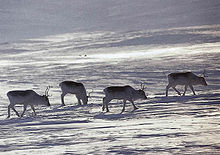 The Peary caribou is a relatively small and pale subspecies found in the tundra of far northern North America. Unsurprisingly, it is part of the group known as Tundra reindeer.
The Peary caribou is a relatively small and pale subspecies found in the tundra of far northern North America. Unsurprisingly, it is part of the group known as Tundra reindeer.
Since 1961, reindeer have been divided into two major groups, the tundra reindeer with six subspecies and the woodland reindeer with three subspecies.[citation needed] Among the tundra subspecies are small-bodied, high-Arctic island forms. These island subspecies are probably not closely related, since the Svalbard reindeer seems to have evolved from large European reindeer, whereas Peary caribou and the extinct Arctic reindeer are closely related and probably evolved in high-Arctic North America.[2]
The following list is partial, as four subspecies which are restricted to Russia and neighbouring regions have been left out. These are R. tarandus buskensis, R. tarandus pearsoni (Novaya Zemlya reindeer), R. tarandus phylarchus (Kamchatka/Okhotsk reindeer) and R. tarandus sibiricus (Siberian Tundra reindeer).[28]
Tundra reindeer
- †Arctic reindeer (R. tarandus eogroenlandicus), an extinct subspecies found until 1900 in eastern Greenland.
- Peary caribou (R. tarandus pearyi), found in the northern islands of the Nunavut and the Northwest Territories of Canada.
- Svalbard reindeer (R. tarandus platyrhynchus), found on the Svalbard islands of Norway, is the smallest subspecies of reindeer.
- Mountain reindeer (R. tarandus tarandus), found in the Arctic tundra of Eurasia, including the Fennoscandia peninsula of northern Europe.
- Porcupine caribou or Grant's caribou (R. tarandus granti), which are found in Alaska, the Yukon, and the Northwest Territories of Canada. Very similar to R. tarandus groenlandicus, and probably better regarded as a junior synonym of that subspecies.[28][29]
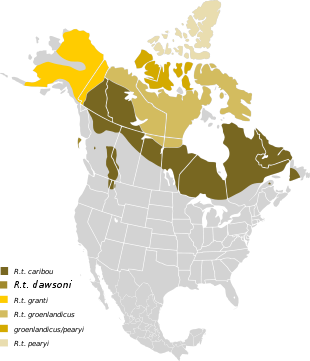 Approximate range of caribou subspecies in North America. Overlap is possible for contiguous range. Subspecies groenlandicus and pearyi mix on some arctic islands, and granti is probably a synonym of groenlandicus. Populations here included in caribou are sometimes divided into four separate subspecies (see text)
Approximate range of caribou subspecies in North America. Overlap is possible for contiguous range. Subspecies groenlandicus and pearyi mix on some arctic islands, and granti is probably a synonym of groenlandicus. Populations here included in caribou are sometimes divided into four separate subspecies (see text)
- Barren-ground caribou (R. tarandus groenlandicus), found in Nunavut and the Northwest Territories of Canada and in western Greenland.
Woodland reindeer
- Finnish forest reindeer (R. tarandus fennicus), found in the wild in only two areas of the Fennoscandia peninsula of Northern Europe, in Finnish/Russian Karelia, and a small population in central south Finland. The Karelia population reaches far into Russia, however, so far that it remains an open question whether reindeer further to the east are R. t. fennicus as well.
- Migratory woodland caribou (R. tarandus caribou), or forest caribou, once found in the North American taiga (boreal forest) from Alaska to Newfoundland and Labrador and as far south as New England, Idaho, and Washington. Woodland caribou have disappeared from most of their original southern range and are considered threatened where they remain, with the notable exception of the Migratory woodland caribou of northern Quebec and Labrador, Canada. The name of the Cariboo district of central British Columbia relates to their once-large numbers there, but they have almost vanished from that area in the last century. A herd is protected in the Caribou Mountains in Alberta. The above quoted range includes R. tarandus caboti (Labrador caribou), R. tarandus osborni (Osborn's caribou – from British Columbia) and R. tarandus terraenovae (Newfoundland caribou). Based on a review in 1961, these were considered invalid and included in R. tarandus caribou, but some recent authorities have considered them all valid, even suggesting that they are quite distinct.[28][30] An analysis of mtDNA in 2005 found differences between the caribous from Newfoundland, Labrador, south-western Canada and south-eastern Canada, but maintained all in R. tarandus caribou.[29]
- †Queen Charlotte Islands caribou (R. tarandus dawsoni) from the Queen Charlotte Islands was believed to represent a distinct subspecies. It became extinct at the beginning of the 20th century. However, recent DNA analysis from mitochondrial DNA of the remains from those reindeer suggest that the animals from the Queen Charlotte Islands were not genetically distinct from the Canadian mainland reindeer subspecies.[3]
Reindeer and humans
Hunting
Reindeer hunting by humans has a very long history, and caribou/wild reindeer "may well be the species of single greatest importance in the entire anthropological literature on hunting."[4]
Humans started hunting reindeer in the Mesolithic and Neolithic periods, and humans are today the main predator in many areas. Norway and Greenland have unbroken traditions of hunting wild reindeer from the ice age until the present day. In the non-forested mountains of central Norway, such as Jotunheimen, it is still possible to find remains of stone-built trapping pits, guiding fences, and bow rests, built especially for hunting reindeer. These can, with some certainty, be dated to the Migration Period, although it is not unlikely that they have been in use since the Stone Age.
Norway is now preparing to apply for nomination as a World Heritage Site for areas with traces and traditions of reindeer hunting in Dovrefjell-Sunndalsfjella National Park, Reinheimen National Park and Rondane National Park in Central Sør-Norge (Southern Norway). There is in these parts of Norway an unbroken tradition of reindeer hunting from post-glacial stone age until today.
Wild caribou are still hunted in North America and Greenland. In the traditional lifestyle of the Inuit people, Northern First Nations people, Alaska Natives, and the Kalaallit of Greenland, the caribou is an important source of food, clothing, shelter, and tools. Many Gwichʼin people, who depend on the Porcupine caribou, still follow traditional caribou management practices that include a prohibition against selling caribou meat and limits on the number of caribou to be taken per hunting trip.[31]
The blood of the caribou was supposedly mixed with alcohol as drink by hunters and loggers in colonial Quebec to counter the cold. This drink is now enjoyed without the blood as a wine and whiskey drink known as Caribou.[32][33]
Reindeer husbandry
Reindeer have been herded for centuries by several Arctic and Subarctic people including the Sami and the Nenets. They are raised for their meat, hides, antlers and, to a lesser extent, for milk and transportation. Reindeer are not considered fully domesticated, as they generally roam free on pasture grounds. In traditional nomadic herding, reindeer herders migrate with their herds between coast and inland areas according to an annual migration route, and herds are keenly tended. However, reindeer were not bred in captivity, though they were tamed for milking as well as for use as draught animals or beasts of burden.
The use of reindeer as semi-domesticated livestock in Alaska was introduced in the late 19th century by the U.S. Revenue Cutter Service, with assistance from Sheldon Jackson, as a means of providing a livelihood for Native peoples there.[34] Reindeer were imported first from Siberia, and later also from Norway. A regular mail run in Wales, Alaska, used a sleigh drawn by reindeer.[35] In Alaska, reindeer herders use satellite telemetry to track their herds, using online maps and databases to chart the herd's progress.
Economy
The reindeer has (or has had) an important economic role for all circumpolar peoples, including the Saami, Nenets, Khants, Evenks, Yukaghirs, Chukchi, and Koryaks in Eurasia. It is believed that domestication started between the Bronze and Iron Ages. Siberian deer owners also use the reindeer to ride on (Siberian reindeer are larger than their Scandinavian relatives). For breeders, a single owner may own hundreds or even thousands of animals. The numbers of Russian herders have been drastically reduced since the fall of the Soviet Union. The fur and meat is sold, which is an important source of income. Reindeer were introduced into Alaska near the end of the 19th century; they interbreed with native caribou subspecies there. Reindeer herders on the Seward Peninsula have experienced significant losses to their herds from animals (such as wolves) following the wild caribou during their migrations.
Reindeer meat is popular in the Scandinavian countries. Reindeer meatballs are sold canned. Sautéed reindeer is the best-known dish in Lapland. In Alaska and Finland, reindeer sausage is sold in supermarkets and grocery stores. Reindeer meat is very tender and lean. It can be prepared fresh, but also dried, salted, hot- and cold-smoked. In addition to meat, almost all internal organs of reindeer can be eaten, some being traditional dishes.[36] Furthermore, Lapin Poron liha, fresh reindeer meat completely produced and packed in Finnish Lapland, is protected in Europe with PDO classification.[37][38]
Reindeer antler is powdered and sold as an aphrodisiac, nutritional or medicinal supplement to Asian markets.
Caribou have been a major source of subsistence for Canadian Inuit.
In history
Both Aristotle and Theophrastus have short accounts – probably based on the same source – of an ox-sized deer species, named tarandos, living in the land of the Bodines in Scythia, which was able to change the colour of its fur to obtain camouflage. The latter is probably a misunderstanding of the seasonal change in reindeer fur colour. The descriptions have been interpreted as being of reindeer living in the southern Ural Mountains at c. 350 BC[39]
A deer-like animal described by Julius Caesar in his Commentarii de Bello Gallico (chapter 6.26) from the Hercynian Forest in the year 53 BC is most certainly to be interpreted as reindeer:[39][40]
There is an ox shaped like a stag. In the middle of its forehead a single horn grows between its ears, taller and straighter than the animal horns with which we are familiar. At the top this horn spreads out like the palm of a hand or the branches of a tree. The females are of the same form as the males, and their horns are the same shape and size.According to Olaus Magnus's Historia de Gentibus Septentrionalibus – printed in Rome in 1555 – Gustav I of Sweden sent 10 reindeer to Albert I, Duke of Prussia, in the year 1533. It may be these animals that Conrad Gessner had seen or heard of.
Name etymology
The name rangifer, which Linnaeus chose as the name for the reindeer genus, was used by Albertus Magnus in his De animalibus, fol. Liber 22, Cap. 268: "Dicitur Rangyfer quasi ramifer". This word may go back to a Saami word raingo.[39] For the origin of the word tarandus, which Linnaeus chose as the species epithet, he made reference to Ulisse Aldrovandi's Quadrupedum omnium bisulcorum historia fol. 859–863, Cap. 30: De Tarando (1621). However, Aldrovandi – and before him Konrad Gesner[41] – thought that rangifer and tarandus were two separate animals.[42] In any case, the tarandos name goes back to Aristotle and Theophrastus – see above.
Local names
The name rein (-deer) is of Norse origin (Old Norse hreinn, which again goes back to Proto-Germanic *hrainaz and Proto-Indo-European *kroinos meaning "horned animal"). In the Uralic languages, Sami poatsu (in Northern Sami boazu, in Lule Sami boatsoj, in Pite Sami båtsoj, in Southern Sami bovtse), Mari pučə and Udmurt pudžej, all referring to domesticated reindeer, go back to *počaw, an Iranian loanword deriving from Proto-Indo-European *peḱu-, meaning "cattle". The Finnish name poro may also stem from the same.[43] The name caribou comes, through French, from Mi'kmaq qalipu, meaning "snow shoveler", referring to its habit of pawing through the snow for food.[44] In Inuktitut, the caribou is known by the name tuktu.[45][46] In Cree-Montagnais-Naskapi dialects the caribou is called atihkw.
Reindeer in Christmas
Santa Claus's reindeer
In the Santa Claus tale, Santa Claus's sleigh is pulled by flying reindeer. These were first named in the 1823 poem "A Visit from St. Nicholas", where they are called Dasher, Dancer, Prancer, Vixen, Comet, Cupid, Dunder, and Blixem.[47] Dunder was later changed to Donder and—in other works—Donner (in German, "thunder"), and Blixem was later changed to Bliksem, then Blitzen (German for "lightning"). Some consider Rudolph as part of the group as well, though he was not part of the original named work referenced previously. Rudolph was added by Robert L. May in 1939 as "Rudolph the Red-Nosed Reindeer".
According to the British comedy panel game QI, Rudolph the Red-Nosed Reindeer and all of Santa's other reindeer must be either female or castrated, because male reindeer lose their antlers during winter.
Heraldry and symbols
Several Norwegian municipalities have one or more reindeer depicted in their coats-of-arms: Eidfjord, Porsanger, Rendalen, Tromsø, Vadsø, and Vågå. The historic province of Västerbotten in Sweden has a reindeer in its coat of arms. The present Västerbotten County has very different borders and uses the reindeer combined with other symbols in its coat-of-arms. The city of Piteå also has a reindeer. The logo for Umeå University features three reindeer.
The Canadian 25-cent coin, or "quarter" features a depiction of a caribou on one face. The caribou is the official provincial animal of Newfoundland and Labrador, Canada, and appears on the coat of arms of Nunavut. A caribou statue was erected at the center of the Beaumont-Hamel Newfoundland Memorial, marking the spot in France where hundreds of soldiers from Newfoundland were killed and wounded in the First World War and there is a replica in Bowring Park, in St. John's, Newfoundland's capital city.
Two municipalities in Finland have reindeer motifs in their coats-of-arms: Kuusamo[48] has a running reindeer and Inari[49] a fish with reindeer antlers.
See also
- Rangifer (journal)
References
- ^ a b c d e f Henttonen, H. & Tikhonov, A. (2008). Rangifer tarandus. In: IUCN 2008. IUCN Red List of Threatened Species. Downloaded on 29 April 2010.
- ^ a b Peter Gravlund, Morten Meldgaard, Svante Pääbo, and Peter Arctander (1998). "Polyphyletic Origin of the Small-Bodied, High-Arctic Subspecies of Tundra Reindeer (Rangifer tarandus)". Molecular Phylogenetics and Evolution 10 (2): 151–9. doi:10.1006/mpev.1998.0525. PMID 9878226.
- ^ a b S. A. Byun, B. F. Koop, and T. E. Reimchen (2002). "Evolution of the Dawson caribou (Rangifer tarandus dawsoni)". Can. J. Zool. 80 (5): 956–960. doi:10.1139/z02-062.
- ^ a b "In North America and Eurasia the species has long been an important resource—in many areas the most important resource—for peoples inhabiting the northern boreal forest and tundra regions. Known human dependence on caribou/wild reindeer has a long history, beginning in the Middle Pleistocene (Banfield 1961:170; Kurtén 1968:170) and continuing to the present....The caribou/wild reindeer is thus an animal that has been a major resource for humans throughout a tremendous geographic area and across a time span of tens of thousands of years." Ernest S. Burch, Jr. (1972). "The Caribou/Wild Reindeer as a Human Resource". American Antiquity 37 (3): 339–368. doi:10.2307/278435. JSTOR 278435.
- ^ Flying Reindeer and Santa Claus: Fact, Fiction and Myth. Icr.arcticportal.org (2008-12-15). Retrieved on 2011-09-16.
- ^ The Sámi and their reindeer – University of Texas at Austin
- ^ a b c Novak, R. M. (editor) (1999). Walker's Mammals of the World. Vol. 2. 6th edition. Johns Hopkins University Press, Baltimore. pp. 1128–1130. ISBN 0-8018-5789-9
- ^ Sommer R. S. and Nadachowski A. (2006). "Glacial refugia of mammals in Europe: evidence from fossil records". Mammal Rev 36 (4): 251–265. doi:10.1111/j.1365-2907.2006.00093.x.
- ^ Europe's last wild reindeer herds in peril. Newscientist. 19 December 2003. Retrieved on 2011-09-16.
- ^ Reindeer Hunting in Iceland. International Adventure. Accessed 12 November 2010.
- ^ BBC Earth News-Reindeer herds in global decline. BBC News (2009-06-11). Retrieved on 2011-09-16.
- ^ Vors, L. S and Boyce, M. S. (2009). "Global declines of caribou and reindeer". Global Change Biology 15 (11): 2626–2633. doi:10.1111/j.1365-2486.2009.01974.x.
- ^ a b Caribou at the Alaska Department of Fish & Game. Adfg.state.ak.us. Retrieved on 2011-09-16.
- ^ a b c Aanes, R. (2007). Svalbard reindeer. Norwegian Polar Institute.
- ^ a b c Reid, F. (2006). Mammals of North America. Peterson Field Guides. ISBN 978-0-395-93596-5
- ^ a b New World Deer (Capriolinae).[dead link] Answers.com
- ^ "In the winter, the fleshy pads on these toes grow longer and form a tough, hornlike rim. Caribou use these large, sharp-edged hooves to dig through the snow and uncover the lichens that sustain them in winter months. Biologists call this activity "cratering" because of the crater-like cavity the caribou’s hooves leave in the snow." All About Caribou – Project Caribou
- ^ Image of reindeer cratering in snow. Arcticphoto.co.uk. Retrieved on 2011-09-16.
- ^ Banfield AWF: The caribou. In The Unbelievable Land. Smith I.N. (ed.) Ottawa: Queen's Press; 1966: 25–28, cited in Jakob Bro-Jørgensen and Torben Dabelsteen (2008). "Knee-clicks and visual traits indicate fighting ability in eland antelopes: multiple messages and back-up signals". BMC Biology 6: 47. doi:10.1186/1741-7007-6-47. PMC 2596769. PMID 18986518. http://www.pubmedcentral.nih.gov/articlerender.fcgi?tool=pmcentrez&artid=2596769.
- ^ Reindeer use UV light to survive in the wild. Ucl.ac.uk (2011-05-26). Retrieved on 2011-09-16.
- ^ Lemmings at Hinterland Who's Who
- ^ Terrestrial Mammals of Nunavut by Ingrid Anand-Wheeler. ISBN 1-55325-035-4.
- ^ ''The Sun, the Moon and Firmament in Chukchi Mythology and on the Relations of Celestial Bodies and Sacrifice'' by Ülo Siimets at 140. (PDF) . Retrieved on 2011-09-16.
- ^ Caribou Migration Monitoring by Satellite Telemetry. Mrnf.gouv.qc.ca. Retrieved on 2011-09-16.
- ^ Walker, Matt. (2009-10-20) Eagles filmed hunting reindeer. BBC News. Retrieved on 2011-09-16.
- ^ Caribou Foes: Natural Predators in the Wilderness. Learner.org. Retrieved on 2011-09-16.
- ^ Greenland Shark (Somniosus microcephalus). Postmodern.com. Retrieved on 2011-09-16.
- ^ a b c Grubb, Peter (16 November 2005). Wilson, Don E., and Reeder, DeeAnn M., eds. ed. Mammal Species of the World (3rd ed.). Baltimore: Johns Hopkins University Press, 2 vols. (2142 pp.). ISBN 978-0-8018-8221-0. OCLC 62265494. http://www.bucknell.edu/msw3/browse.asp?id=14200328.
- ^ a b Cronin, M. A., M. D. Macneil, and J. C. Patton (2005). Variation in Mitochondrial DNA and Microsatellite DNA in Caribou (Rangifer tarandus) in North America. Journal of Mammalogy 86(3): 495–505.
- ^ Geist, V. (2007). Defining subspecies, invalid taxonomic tools, and the fate of the woodland caribou. The Eleventh North American Caribou Workshop (2006). Rangifer, Special Issue 17: 25-28.
- ^ Gwichʼin Traditional Management Practices. Arcticcircle.uconn.edu. Retrieved on 2011-09-16.
- ^ Mieusset, Sébastien. "Le "Temps des sucres" au Québec". http://www.cuisine.tv/cid6799/le-temps-des-sucres-au-quebec.html
- ^ Ovenell-Carter, Julie (06-02-2009). "Quebec's Carnaval is worth freezing your a** off for". theseboots.travel. http://theseboots.travel/2009/02/06/worth-repeating-quebecs-carnaval-is-worth-freezing-your-a-off-for/
- ^ King, Irving H.(1996). The Coast Guard Expands, p. 86–91. Naval Institute Press, Annapolis, Maryland. ISBN 155750458X.
- ^ United States. Bureau of Education; United States. Bureau of Education. Alaska Division (1905). Annual report on introduction of domestic reindeer into Alaska. 14. Govt. Print. Off.. pp. 18–. http://books.google.com/books?id=6RcWb-PNMiMC&pg=PA18. Retrieved 16 September 2011.
- ^ Reindeer. Saunalahti.fi. Retrieved on 2011-09-16.
- ^ 'Lapland Reindeer meat protected in the EU' North Magazine (Accessed 19 July 2010)
- ^ European Commission PDO/PGI list (Accessed 19 July 2010)
- ^ a b c Sarauw, Georg (1914). "Das Rentier in Europa zu den Zeiten Alexanders und Cæsars [The reindeer in Europe to the times of Alexander the Great and Julius Caesar]". In Jungersen, H. F. E.; Warming, E. (in German). Mindeskrift i Anledning af Hundredeaaret for Japetus Steenstrups Fødsel. Copenhagen. pp. 1–33.
- ^ "Est bos cervi figura, cuius a media fronte inter aures unum cornu* exsistit excelsius magisque directum his, quae nobis nota sunt, cornibus: ab eius summo sicut palmae ramique* late diffunduntur. Eadem est feminae marisque natura, eadem forma magnitudoque cornuum." Greenough, J. B.; D'Ooge, Benjamin L.; Daniell, M. Grant (1898). "book 6, chapter 26". Commentary on Caesar, Gallic War. Boston: Ginn and Company. http://old.perseus.tufts.edu/cgi-bin/ptext?doc=Perseus%3Atext%3A1999.04.0017&query=chapter%3D%23242.
- ^ Gesner, K. (1617) Historia animalium. Liber 1, De quadrupedibus viviparis. Tiguri 1551. p. 156: De Tarando. 9. 950: De Rangifero.
- ^ Aldrovandi, U. (1621) Quadrupedum omnium bisulcorum historia. Bononiæ. Cap. 30: De Tarando – Cap. 31: De Rangifero.
- ^ Koivulehti, Jorma (2007): Saamen ja suomen 'poro'. Mémoires de la Société Finno-Ougrienne 253. http://www.sgr.fi/sust/sust253/sust253_koivulehto.pdf
- ^ Flexner, Stuart Berg and Leonore Crary Hauck, eds. (1987). The Random House Dictionary of the English Language, 2nd ed. (unabridged). New York: Random House, pp. 315–16)
- ^ Spalding, Alex, Inuktitut – A Multi-Dialectal Outline Dictionary (with an Aivilingmiutaq base). Nunavut Arctic College, Iqaluit, Nunavut, Canada, 1998.
- ^ Eskimoisches Wörterbuch, gesammelt von den Missionaren in Labrador, revidirt und herausgegeben von Friedrich Erdmann. Budissin [mod. Bautzen] 1864.
- ^ "The Legendary Role of Reindeer in Christmas, Jeff Westover, My Merry Christmas, accessed 27 December 2007
- ^ Coat of arms for Kuusamo.
- ^ Coat of arms for Inari.
External links
- The Reindeer Portal, Source of Information About Reindeer Husbandry Worldwide
- Rangifer.net has a map of subspecies ranges.
- 1935 Reindeer Herding in the Northwest Territories
- General information on Caribou and Reindeer
- Human Role in Reindeer/Caribou Systems
- Reindeer Studies in South Georgia and Norway
- Reindeer hunting as World Heritage – a ten thousand year-long tradition
- The Scandinavian reindeer (Rangifer tarandus L.) after the last glacial maximum: time, seasonality and human exploitation
- Adaptations To Life In The Arctic – Instructional slide-show, University of Alaska
- Rangifer – world's only scientific journal dealing exclusively with husbandry, management and biology of Arctic and northern ungulates
 Texts on Wikisource:
Texts on Wikisource:
- "Reindeer". New International Encyclopedia. 1905.
- Chisholm, Hugh, ed (1911). "Reindeer". Encyclopædia Britannica (11th ed.). Cambridge University Press.
Caribou-specific links (North America)
- Mammal Fact Sheets: Caribou
- Frequently Asked Questions about Caribou from the Arctic National Wildlife Refuge
- Caribou and You – Campaign by CPAWS to protect the Woodland caribou, a species at risk in Canada
- Newfoundland Five-Year Caribou Strategy Seeks to Address Declining Populations
Game animals and shooting in North America Game birds Bobwhite Quail · Chukar · Hungarian Partridge · Prairie Chicken · Mourning Dove · Ring-necked pheasant · Ptarmigan · Ruffed Grouse · Sharp-tailed Grouse · Snipe (Common Snipe) · Spruce Grouse · Turkey · WoodcockWaterfowl Black Duck · Canada Goose · Canvasback · Gadwall · Greater Scaup · Lesser Scaup · Mallard · Northern Pintail · Redhead · Ross's Goose · Snow Goose · Wood DuckBig game Bighorn Sheep · Black Bear · Razorback · Brown Bear · Bison (Buffalo) · Caribou · Cougar (Mountain Lion) · Elk · Moose · White-tailed deer · Gray wolf · Mountain goat · Mule Deer · Pronghorn · Muskox · Dall Sheep · Polar BearOther quarry American alligator · Bobcat · Coyote · Fox Squirrel · Gray Fox · Gray Squirrel · Opossum · Rabbit · Raccoon · Red Fox · Snowshoe HareSee also Categories:- IUCN Red List least concern species
- Reindeer
- Deer
- Fauna of the Arctic
- Arctic land animals
- Mammals of Europe
- Mammals of Asia
- Mammals of Canada
- Fauna of Greenland
- Mammals of Russia
- Mammals of the United States
- Megafauna of Eurasia
- Megafauna of North America
- Alaskan cuisine
- Algonquian loanwords
- Monotypic mammal genera
- Animals described in 1758
Wikimedia Foundation. 2010.



